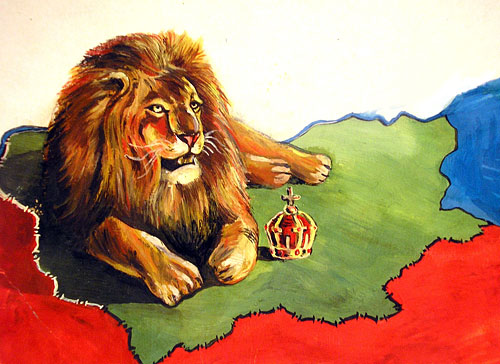Deleted member 67076
For those who don't know, Krall and I have decided to partner up and do the Map of the Month challenge, with our entry being a short timeline on quite an underrated medieval state, the Second Bulgarian Empire. One who, while a major regional power for nearly a century, we feel could have had a much better run during its heyday. For the most part, I'll be doing the writing and Krall will do the maps.
But, without further ado:
----------
"The Lion's Roar: Not Just Heard, but Felt".But, without further ado:
----------
By Soverihn and Krall

Part 1: The Lion Awakes
1204: The year that changed everything. For good or for ill, the so called ‘Knights of Christ’ attacked the holy city of Constantinople, where they gave way to days of sacking, looting and burning. Their greed would cause the end of one of the greatest and longest empires to ever grace the face of Earth.
With the entrance of crusaders,the immutable Roman Empire was put to the sword and butchered by the Latins, its lands divided as spoils for the victorious forces. In its place came out the western controlled Latin Empire, the Duchy of Athens, the Kingdom of Thessalonica, and the Principality of Achaea. What remained under imperial control was broken apart by the squabbling remnants, leading to the establishment of the Despotate of Epirus, the ‘empire’ of Trebizond (really just a long strip of the Pontic Coast) and the Empire of Nicaea. The remainder of the once great empire that had not been carved up by the western vultures was awarded to the most Serene Republic of Venice, arguably the mastermind of the incident.
However, in all this chaos lurked the Second Bulgarian Empire to the north. Formed through rebellion against the decadence of the Angeloi dynasty a mere 20 years ago, this state grew quickly and aggressively under its competent leaders. At the time of the Fourth Crusade, the Second Bulgarian empire encompassing all the lands north of the Rhodope Mountains to the south of the Dnieper River.
And with the destruction of its perennial rival, Bulgaria would enter a new period of domination. Under the leadership of the wily Kaloyan and his successors, a new era of power and glory descend upon the Tsardom of Bulgaria. The Lion of the Balkans would roar- the Second Bulgarian Empire would gain his place in the sun.
-------------
In the immediate aftermath following the Sack of Constantinople Baldwin, the Count of Flanders, claimed dominion over all of Thrace, Bithynia and Greece. However, in doing so he immediately committed a costly mistake: by extending his control over the richest areas of the empire in Europe, he came into conflict with his rival Boniface of Montferrat, leader of the Crusader forces. Days after the crusade, the two clashed over who would receive the crown of Constantinople, and with it the title of Emperor of Romania [1] along with the more tangible reward of what fiefdoms they would rule.
They were not unique in this. Clashes over the spoils of war were depressingly a common occurrence among crusading troops following victories, something that would divide and weaken them again and again. This was no exception to the rule: the altercation over who would receive the crown quickly grew into a major split among the formerly unified crusading forces, causing the newly controlled Latin Empire to divide itself less than 3 months after its formation. Baldwin based himself in Constantinople and was declared emperor, whilst Boniface took his troops and marched into Macedonia. There, he established his power base in northern Greece, and formed the Kingdom of Thessalonica. Neither established firm control over Thrace, despite Baldwin’s claim over the territory and so skirmishes between the Latins would result.
At the same time, the division of territory left a void in power in contested Thrace, which the conquered Roman populace used to expel the Latin garrison from Adrianople and attempt to reclaim their homelands for themselves. However, peasant armies were little match for trained soldiers, so they called upon a protector to aid them in their endeavors. With this call, the Lion of the East would awake from his slumber.
Messages were dispatched to the court at Tarnovo, where the reigning tsar Kaylon saw this as an opportunity to increase his influence and expand south. As soon as he could, Kaloyan prepared for war. In February the time was right, and Kaloyan’s host set forth.
[1] Most Westerners refused to call it the Roman Empire, instead calling it things like ‘Empire of the Greeks’ or ‘Empire of the Romanians’.
-----
Of further note, all of this update is prior all according OTL. The actual POD shall come on the next update.